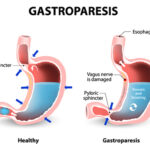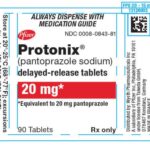Can I Use Omeprazole And Alcohol?

Omeprazole, sold under the brand names Prilosec and Losec among others, is in a class of medications called proton-pump inhibitors. It works by decreasing the amount of acid made in the stomach. It works within 2 to 3 days, although it may take up to 4 weeks for omeprazole to work properly.
Omeprazole was first made in 1979 by Swedish AB Hässle, part of Astra AB. It was the first of the proton pump inhibitors (PPI). Astra AB, now AstraZeneca, launched it as an ulcer medicine under the name Losec in Sweden. It was first sold in the United States in 1989 under the brand name Losec.
What is Omeprazole used to treat?
Prescription omeprazole is used alone or with other medications to treat the symptoms of gastroesophageal reflux disease (GERD), a condition in which backward flow of acid from the stomach causes heartburn and possible injury of the esophagus (the tube between the throat and stomach) in adults and children 1 year of age and older. Prescription omeprazole is used to treat damage from GERD in adults and children 1 month of age and older. Prescription omeprazole is used to allow the esophagus to heal and prevent further damage to the esophagus in adults and children 1 year of age and older with GERD. Prescription omeprazole is also used to treat conditions in which the stomach produces too much acid such as Zollinger-Ellison syndrome in adults.
In addition, prescription omeprazole is used to treat ulcers (sores in the lining of the stomach or intestine) and it is also used with other medications to treat and prevent the return of ulcers caused by a certain type of bacteria (H. pylori) in adults. Nonprescription (over-the-counter) omeprazole is used to treat frequent heartburn (heartburn that occurs at least 2 or more days a week) in adults.
How to use omeprazole
Prescription omeprazole comes as a delayed-release (releases the medication in the intestine to prevent break-down of the medication by stomach acids) capsule, and packets of delayed-release (releases the medication in the intestine to prevent break-down of the medication by stomach acids) granules for suspension (to be mixed with liquid) to take by mouth or give through a feeding tube. Nonprescription (over-the-counter) omeprazole comes as a delayed-release tablet to take by mouth. Prescription omeprazole should be taken at least 1 hour before a meal. Prescription omeprazole is usually taken once a day before a meal but may be taken twice a day when used with other medications to eliminate H. pylori, or up to three times a day, before meals when used to treat conditions in which the stomach produces too much acid. The nonprescription delayed-release tablets are usually taken once a day in the morning at least 1 hour before eating for 14 days in a row. If needed, additional 14-day treatments may be repeated, not more often than once every 4 months. To help you remember to take omeprazole, take it at around the same time(s) every day. Follow the directions on your prescription label or the package label carefully, and ask your doctor or pharmacist to explain any part you do not understand. Take omeprazole exactly as directed. Do not take more or less of it or take it more often or for a longer period of time than prescribed by your doctor or stated on the package.
If you are taking the delayed-release tablets, swallow them whole with a full glass of water. Do not split, chew, or crush them or crush and mix them into food.
Swallow the delayed-release capsules whole. If you have difficulty swallowing the delayed-release capsules, place one tablespoon of soft, cool applesauce in an empty bowl. Open the delayed-release capsule and carefully empty all the granules inside the capsule onto the applesauce. Mix the granules with the applesauce and swallow the mixture immediately with a glass of cool water. Do not chew or crush the granules. Do not store the applesauce/granule mixture for future use.
If you are taking the granules for oral suspension, you will need to mix it with water before use. If you are using the 2.5-mg packet, place 1 teaspoonful (5 mL) of water in a container. If you are using the 10-mg packet, place 1 tablespoonful (15 mL) of water in a container. Add the contents of the powder packet and stir. Wait 2 to 3 minutes to allow the mixture to thicken, and stir the mixture again. Drink the entire mixture within 30 minutes. If any of the mixture is stuck to the container, pour more water into the container, stir and drink all the mixture immediately.
The granules for oral suspension can be given through a feeding tube. If you have a feeding tube, ask your doctor how you should take the medication. Follow the directions carefully.
Do not take nonprescription omeprazole for immediate relief of heartburn symptoms. It may take 1 to 4 days for you to feel the full benefit of the medication. Call your doctor if your symptoms get worse or do not improve after 14 days or if your symptoms return sooner than 4 months after you finish your treatment. Do not take nonprescription omeprazole for longer than 14 days or treat yourself with omeprazole more often than once every 4 months without talking to your doctor.
Continue to take prescription omeprazole even if you feel well. Do not stop taking prescription omeprazole without talking to your doctor. If your condition does not improve or gets worse, call your doctor.
Ask your pharmacist or doctor for a copy of the manufacturer’s information for the patient.
Can I use omeprazole and alcohol?
Studies have shown that alcohol does not affect the way omeprazole works. However, drinking alcohol makes your stomach produce more acid than normal. This can irritate your stomach lining and make your symptoms worse. In addition, if omeprazole makes you feel dizzy, then drinking alcohol is likely to make this worse also, in which case it’s best avoided.
What are the side effects of taking Omeprazole?
Omeprazole may cause side effects. Tell your doctor if any of these symptoms are severe or do not go away:
- constipation
- gas
- nausea
- diarrhea
- vomiting
- headache
Some side effects can be serious. If you experience any of these symptoms, call your doctor immediately, or get emergency medical help:
- rash
- hives
- itching
- swelling of the face, throat, tongue, lips, eyes, hands, feet, ankles, or lower legs
- difficulty breathing or swallowing
- hoarseness
- irregular, fast, or pounding heartbeat
- excessive tiredness
- dizziness
- lightheadedness
- muscle spasms, cramps, or weakness
- jitteriness
- uncontrollable shaking of a part of the body
- seizures
- severe diarrhea with watery stools, stomach pain, or fever that does not go away
- rash on cheeks or arms that is sensitive to sunlight
increased or decreased urination, blood in urine, fatigue, nausea, loss of appetite, fever, rash, or joint pain
People who take proton pump inhibitors such as omeprazole may be more likely to fracture their wrists, hips, or spine than people who do not take one of these medications. People who take proton pump inhibitors may also develop fundic gland polyps (a type of growth on the stomach lining). These risks are highest in people who take high doses of one of these medications or take them for one year or longer. Talk to your doctor about the risk of taking omeprazole.
Omeprazole may cause other side effects. Call your doctor if you have any unusual problems while taking this medication.
Omeprazole Safety Information
Omeprazole appears to be safe for short-term use, but further studies are needed to assess long-term safety because the significance of chronically elevated gastrin levels in children is unknown. Omeprazole has adverse influences on pharmacokinetics of medications such as diazepam, carbamazepine, clozapine, indinavir, nelfinavir, atazanavir, rilpivirine, methotrexate (MTX), tacrolimus, mycophenolate mofetil (MMF), clopidogrel, digoxin, itraconazole, posaconazole, and oral iron supplementation.





